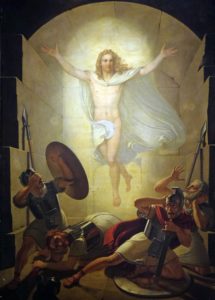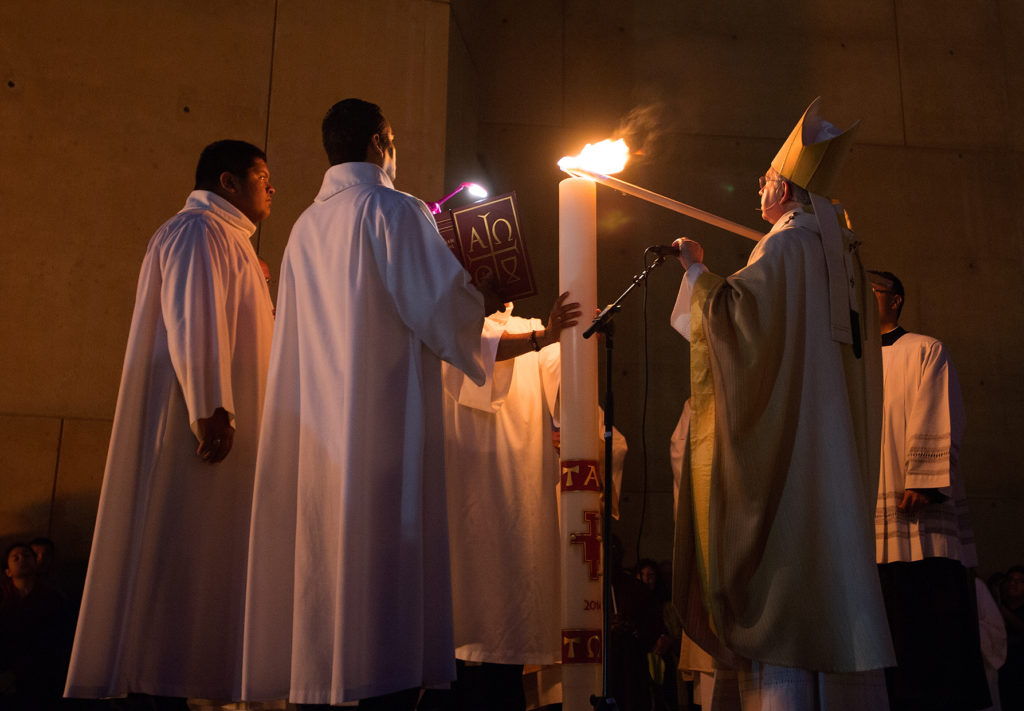Even if you are not a big J.R.R. Tolkien fan, if you have ever watched the film “The Lord of the Rings: The Return of the King,” you were probably moved by one powerful scene.
At the instigation of the wizard Gandalf, the hobbit Pippin secretly climbs up a tower in order to light the signal beacon that will summon the allies of a far-distant kingdom to come to the military aid of their own. The beacon erupts in a blaze. Mere seconds later, on a distant mountain peak, another beacon fire suddenly alights…and then another and another and another, covering a massive geographical span.
At the sight of the flaming beacon, Gandalf quietly declares, “Hope is kindled.”
Dispelling the darkness
Such is the power of fire. The Church knows this. The Church’s genius shines in her Easter Vigil liturgy which begins with the Lucernarium — the blessing of the Easter fire and the preparation of the paschal candle. As the priest blesses the new fire, he prays that we may be “inflamed with heavenly desires.” Then, having lit the paschal candle from the new fire, the priest prays: “May the light of Christ rising in glory dispel the darkness of our hearts and minds.”
With that, the people of God, carrying lighted candles, follow the paschal candle in procession into the church, where the priest or deacon sings the Easter Proclamation, the Exsultet, once known as the “Praise of the Candle” (Laus Cerei). Why do Catholics sing to a candle?
Because this candle represents the risen Son of God, “the one Morning Star who never sets,” who, “coming back from death’s domain, has shed his peaceful light on humanity.”
But most wondrous of all, the Church begs that this “pillar,” which is “a torch so precious,” may throughout the whole of the night “persevere undimmed to overcome the darkness of this night. May this flame be found still burning by the Morning Star: Christ your Son” on Easter morning. Because we all need a beacon. We all need a fire that enkindles our hope.
The great Cistercian abbot Bl. Guerric of Igny (+1157) seems to be speaking for us today when he writes in an Easter homily:
“For myself, when I looked upon the dead Jesus I was overwhelmed by despairing grief. My heart was sorrowing for him as slain, but now that he is risen, not only my heart but my flesh also rejoices in the confident hope of my own resurrection and immortality.”
His best expression of this rejoicing alludes to light:
“As the new sun rises from below, the grace of the Resurrection already casts its radiance over the whole world, a radiance reflected in the eyes of those who have watched for him since daybreak, a dawn that ushers in the day of eternity. This is the day that knows no evening, the day whose sun will never set again.”

The Via Lucis
During these 50 days of Easter, we do not want to return to the darkness again. How can we keep the sun from setting?
The Church comes to our aid with an apt devotional practice recently developed — the Via Lucis. The Church’s “Directory for Popular Piety” describes the Via Lucis this way:
“Following the model of the Via Crucis, the faithful process while meditating on the various appearances of Jesus — from his Resurrection to his Ascension…. Through the Via Lucis, the faithful recall the central event of the Faith — the Resurrection of Christ — and their discipleship in virtue of Baptism…. The Via Lucis … can effectively convey a living understanding to the faithful of the second moment of the Pascal event, namely the Lord’s Resurrection…. Using the metaphor of a journey, the Via Lucis moves from the experience of suffering … to the hope of arriving at man’s true end: liberation, joy, and peace which are essentially Paschal values” (#153).
As we follow the beacon of the Via Lucis, moving from Easter event to Easter event, the mystery of Christ’s resurrection will take hold of us, especially where we are most prone to anxiety, hopelessness, or sorrow.
In the words of Servant of God Luigi Giussani:
“Unless you recognize the presence of Mystery, night advances, confusion abounds and — when it touches your freedom — rebellion erupts, or disappointment is so overwhelming that you’ll wait for nothing more and live desiring nothing more. From the mystery of Christ’s Resurrection a new light floods the world, fighting for territory, inch by inch, pushing back the night.”
Pushing back the night
Let’s push back the night, taking to heart Pope Benedict XVI’s awesome assurance:
“Where there is light, life is born, chaos can be transformed. The Resurrection of Jesus is an eruption of light. This Light alone — Jesus Christ — is the true light, something more than the physical phenomenon of light. Let us pray to the Lord that the fragile flame of the candle he has lit in us, the delicate light of his word and his love amid the confusions of this age, will not be extinguished in us, but will become ever stronger and brighter, so that we, with him, can be people of the day, bright stars lighting up our time.”
Or in the words of a 6-year-old student of the Catechesis of the Good Shepherd meditating on the light of the risen Christ radiating from the paschal candle: “It isn’t light; it’s goodness.”

